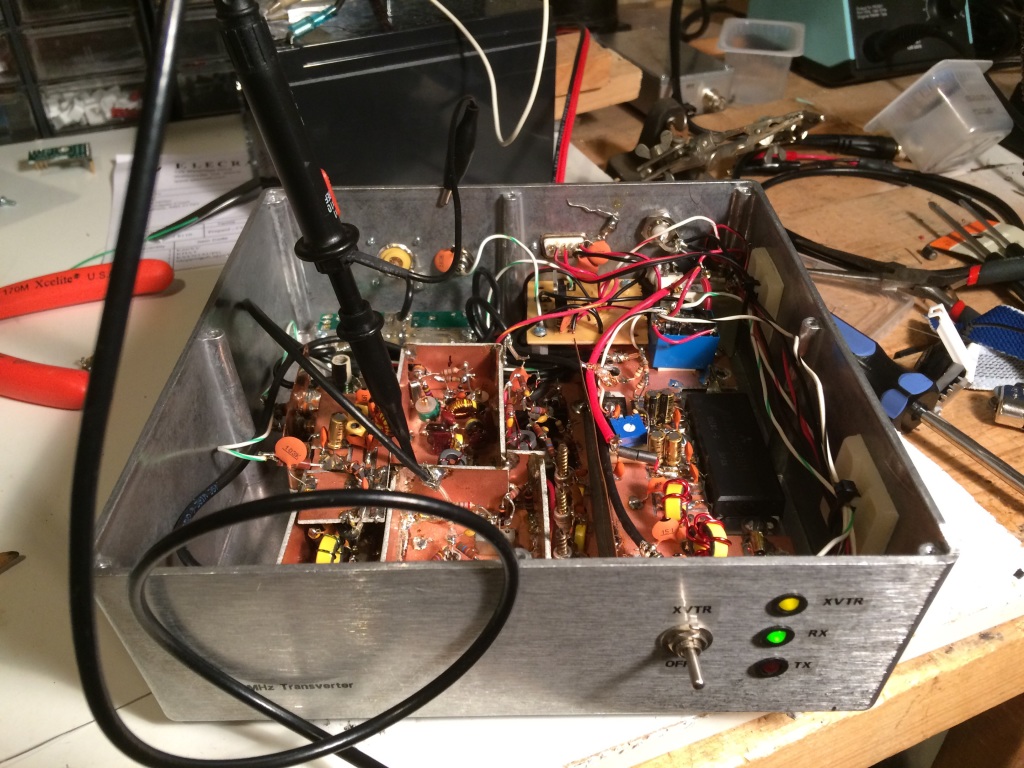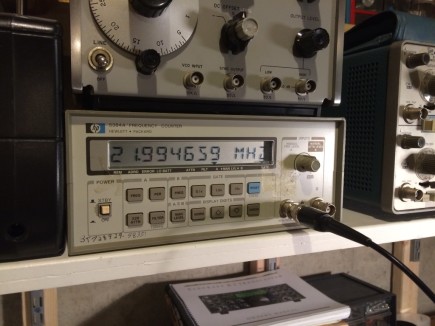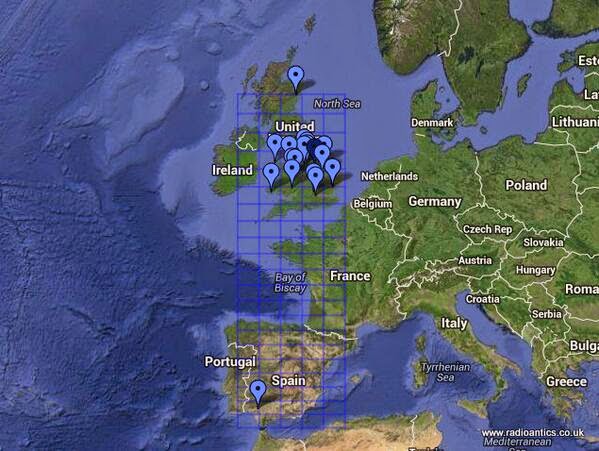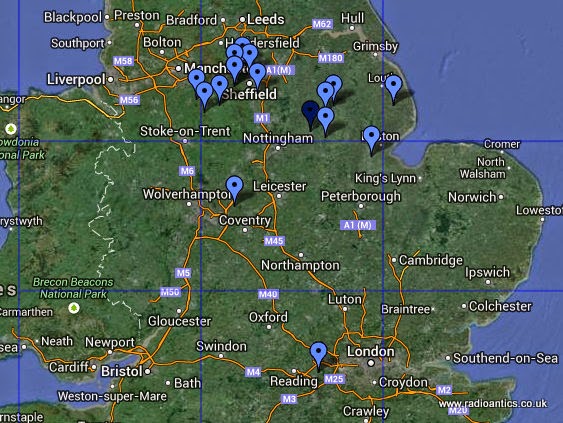Posts Tagged ‘50MHz’
 50-MHz transverter update (Psst! Newark has cheap 22-MHz crystals)
50-MHz transverter update (Psst! Newark has cheap 22-MHz crystals)
A few years ago, I built a 50-MHz transverter to operate 6m with my Kenwood TS-930Ses. I subsequently replaced the two 930s with an Elecraft K3/100 and Elecraft K2/100. The K3 has 6m and I sold off my TS-700S (and my 6m Mirage brick amplifier) to help finance the internal 2m board for the K3. The problem with this arrangement is that I can’t be on 6m and 2m at the same time. I recently assembled and added the SSB board and transverter interface to my K2 (no time to blog about this but they were straightforward additions like everything from Elecraft), now making it an attractive IF for the 6m transverter (and the Microwave Modules 432 transverter I have on the shelf and the 222-MHz transverter I plan to build sometime).
Enter the problem: Because I was thrifty about building the transverter at first, I had used an inexpensive and widely-available 24-MHz crystal for a 26-MHz IF. The TS-930S happily worked here (by the way, pro-tip: A lot of guys say that they liked to have the wideband transmit mods on their HF rigs so they could have a wideband signal source for testing/transverters/etc. The TS-930S will give you a low-level TX out anywhere through the transverter port, even if you don’t have the mod. Well, at least my PIEXX-equipped 930 did). However, the K2 only allows a select set of transverter IF bands to be used natively. Good fortune shone upon my endeavors when I did a quick Google search for 22-MHz crystals and one actually popped up at Newark/Element14 (part number is 86R1720, get ‘em while they’re hot)! Even better news was that it was on closeout for 12 cents apiece! I splurged and bought five, along with some other parts for another project or two I’ll post about eventually.
I carefully peeled back a layer of dead-bug components, extracted the 24-MHz crystal, and replaced it with the new 22-MHz variety, sacrificing only one 4.7-k resistor, an easily-replaced stock item at K8GU. The LO came up about 5.4 kHz low and I couldn’t peak it any higher. So, I’ll either have to futz around with the loading of the crystal or (more likely) load an offset in the K2’s transverter band entry for 6m.
The local W3APL beacon popped up at 28.0694 MHz, which is consistent with the offset I observed above. Now, I just have to get the other interfacing juju worked out to get the K2 to properly command the transverter to transmit and feed it the proper drive level.
 6m QRP rigs
6m QRP rigs
In many ways, 6m (50MHz) is an ideal band for experiments. Short RF leads are always good, but 6m is a forgiving band and you can get away with HF constructional techniques. It is 2MHz wide here in the UK and this means all speech modes can be fitted and used. The page below shows a number of links to 50MHz projects.
See http://www.pg1n.nl/articles.php?lng=en&pg=145 .
See also my Sixbox 6m AM transceiver .
 Noises Off!
Noises Off!
RFI is referred to as QRM or QRN and I am learning the difference.
QRM means "I being interfered with" and is interference coming from someone using radio equipment. This covers deliberate jamming, people tuning up or just normal operations on a crowded band that causes QRM.
QRN means "I am troubled by static" and technically means interference from a natural noises but has come to refer to interference coming from anything that is not an intentional radio emission and interferes with reception of transmissions. So now covers atmospheric noise, static or the noise generated by electronic devices.
Noise isn't a new issue here as I have posted before. It has tended to be sporadic and bearable but since becoming licensed I have become more sensitised to it. Until now I have tended to focus on the VHF/UHF side mainly contesting venturing only briefly onto HF.
My HF set up is limited at the moment with just a single antenna which isn't optimal for the lower bands. Due to the day job I am largely restricted to evening/night time operation when the upper bands have largely been closed anyway so haven't really attacked HF with much enthusiasm apart from data modes such as JT65 and WSPR which have immunity to noise.
When I have got the chance for some early morning daytime operation or at the weekend I have struggled with noise. Recent weekends have seen some special event stations operating for the Museums On The Air and the GB1JSS Summer Solstice which have been predominately on the 40M band but I just cannot hear anything on that band due to noise.
I am aware the Sun has been particular active recently producing a number of large flares and CMEs that have caused a number of radio blackouts, but this noise isn't due to atmospherics I am certain it is man made by one of neighbours.
I made this video last weekend
and this video was from the weekend before that
This weekend was the 50MHz Trophy Contest which I was looking forward to, sadly it was also to become a victim of the QRN as this screenshot from my SDR will confirm, for much of the time I was operating I was just listening to noise.
I wasn't operating constantly, just grabbing a few minutes here and there and I did manage to make some decent contacts when the QRN subsided even catching some of the sporadic E opening to get EF7X in Spain.
I have ruled out any noise being generated by myself by powering everything off and running on battery. This leaves me in a bit of a quandary I could go around and locate and confront the culprit or even contact OFCOM but at the same time I don't want to antagonise anyone who could then object to any antennas I might want to put up in the garden.
Rotating the 6M Moxon around at the weekend during the contest as at least pointed me in the direction of one strong noise source. I am also convince that much of my problem is due to an evil PLT device in an adjacent property.
Following on from the weekend last night was the UKAC 50MHz contest and yet again I was troubled with noise leading to mostly local contacts.
I have been looking at some of the noise cancellers that are available from MFJ and others. I have heard conflicting options on their effectiveness but I am willing to try one if I can obtain one cheaply, or even home-brew one from the numerous designs available.
These devices work by using a second antenna which receives just the noise which is then mixed out of phase with the main antenna signal hence nullifying the noise. By all accounts they are tricky to use and often need constant adjustment but may be my only viable solution at present.
 6m season
6m season
Guess what? Its sunny and there’s Es to be had about. After several months of not really touching the radio at home because of the various commitments I made to a certain cycle sportive I took a week off work and decided to catch up on the family and my hobby. After a nice long weekend away with the kids in Centre Parcs (If you don’t have kids then it’ll be hell on earth, otherwise I can recommend it, especially the security at Sherwood after our friends bike was pinched. The Muppet got nicked at the gate and is now at her majesty’s pleasure)
Back to radio though…A few quick fire contacts on 6m soon had me back in the swing although an attempt at FSK was a step too far today. Still nice to work a few stations and to see the sun out. The Powabeam is doing the business on a Moonraker mast. Not an ideal set up but useful.
 New Radio Thoughts
New Radio Thoughts
As I mentioned in a previous post about my trip to the Aleutians, I am the owner of a new radio. The reasons for the purchase were manifold, but driven by a fundamental shift in the way I view my operating (and living) philosophy. I had long (at least 10 years) been collecting gear for a two- (or three-) tower contest station. In this philosophy, the emphasis was on collecting antennas and towers as they became available on attractive terms. It also meant keeping the inexpensive but well-performing pair of TS-930S HF transceivers for my SO2R setup and the FT-840 for my portable operations. You can imagine from those past few sentences of description alone that this consumed a non-trivial amount of space and time.
Sarah began subtly hinting that “wouldn’t it be nice if we could clean up that pile of tower on the patio so we could have people over?” My parents have been slowly migrating my junkbox from their place to ours. It became increasingly clear to me that as long as we lived in this area it would be unlikely that I would put up the towers. I started contemplating how to remedy this situation. I identified a large collection of gear (including the Rohn 45 on the patio) that 1) could be replaced by a new radio, 2) I was not using, or 3) for which I simply did not have a plan. So, I set out with the following theme to find a new rig:
Excellence in portable operation and competence at home.
I considered four radios: Ten-Tec Eagle, Kenwood TS-590S, Elecraft K2/100, Elecraft K3/100.
I was strongly considering the K2/100 initially. Its size and price seemed attractive. However, when I did the math on what configuration I wanted, it basically ended up a draw with the Kenwood and the Ten-Tec with only a small bump more to the K3/100. Plus, I’ve built enough kits to know that many of life’s most rewarding tasks tend to look better in the past than they do in the future. Personal preference, of course!
The Kenwood TS-590S is acclaimed by a number of contesters as “the poor man’s K3.” It has very similar features and performance numbers at a very attractive price. I have always enjoyed Kenwoods as well. But, the one thing that ultimately killed the TS-590S and the Ten-Tec Eagle was their lack of BCD band-data outputs. The K3 also offered the 2-meter option, IF output (for panadapters), and very easy transverter interfacing. It was really a no-brainer for me at that point since I had sold off enough gear to cover the cost entirely.
I bought the K3 kit and assembled it. Anomalies notwithstanding, it amuses me greatly when people announce to the Elecraft e-mail list that “K3 #7777 is on the air”…it’s hard to keep from responding, “Congratulations on assembling your first LEGO kit.” Unlike the K2, these “modular-kit” radios are very easy to assemble if you have a few hand tools and can follow basic directions.
My friend Oli, DJ9AO, informally asked me to compare the K3 to the TS-930S. I’ve tested (subjectively) the K3 in a couple of demanding environments and I’m pleased to say that the K3 performed well, even with essentially “factory default” settings.
The K3 wins hands-down the strong-signal handling contest, even with the Inrad roofing filter in the TS-930S. 40 meters in ARRL Sweepstakes CW is a good test for this. The FT-840 used to have severe mixing products (“beeps and bloops”). These are not common with the TS-930S, but severe AGC pumping from nearby signals often covered up weaker signals. Neither of these are problems with the K3. In fact, the K3 is so good that you can tell just exactly who has key clicks because it’s possible to find two signals of otherwise identical strength on the S-meter and one will be inaudible within a few hundred Hz and the other will continue to bleed through and pump the AGC. Well-done, Elecraft.
One thing that surprised me about the K3 was its apparently poor performance on the pileups from NA-039. With the BW cranked down to 400 Hz, the filters rang like a bell in a pileup. I have the 400-Hz 8-pole and 2.7-kHz 5-pole filters. Widening the DSP bandwidth out to 700 Hz or so (which switches to the 2.7-kHz roofing filter) alleviated the problem with occasional AGC pumping from louder signals in the pileup. In a post to the PVRC e-mail list recently, Frank, W3LPL, also confirmed that he prefers the 1-kHz 8-pole filter for CW operation. Because I had the opportunity, I recently sprung for the special-order 700-Hz roofing filter. It should arrive in March 2013. I suspect there is considerable tailoring that could be done to the AGC system but I’m not there yet. Once I realized that the bandwidth of 700 Hz was a sweet spot, the radio worked great in the pileups. I have a feeling that I’ll also end up with the 1-kHz filter eventually. But, I rarely open up beyond 700 Hz on CW so it will be interesting to see what is best.
A few other bright spots:
- CW-to-Digital: This is just plain cool. Send with the built-in keyer and the radio modulates PSK31 or RTTY for you. Decode it right on the screen.
- Multifunction knobs: The entire industrial design of the K3 is really unmatched in my opinion. It has just the right number of knobs and menus.
- Options: They are plentiful and easy to install. Keeps the initial cost low(er).
I’m extremely delighted with the K3 so far and my shack is getting more compact. It’s also nice to have a radio with a built-in keyer for once…
 What can you do?
What can you do?
When your PSU gives in, a replacement part costs an arm and a leg and 6m is up?
Not a lot it seems. My ft817 was hearing a lot of eastern and western European stations but with 5w max and a home made antenna you’re not going to get far despite some patient operators on the other end.
Still it was worth a go and thanks to DL5EL for letting me have more than my fair share of attempts.
 Summer contest
Summer contest
I never really thought I would be saying this but I have entered, or rather plan to, enter a contest. Sports radio as it is sometimes called always seems like a bear garden on HF with just about every station barking out ‘CQ Contest’ to claim a few more points. To me it doesn’t sound like a sport unless you’re keen on drowning out the competition.
I have mostly avoided contests as to me it has the perception of something where ‘He who has the largest bank account wins’ and the is little room for tiddlers. So to challenge this perception I shall be entering into something that I think / hope will be a bit more relaxed. The UKSMG Summer Es contest might be the highlight of the 50Mhz calendar but for I shall be operating at the most for 6 hours. The likelihood it will be around 3 hours at best as a tiddler station.
I will be operating at best 100W from my IC7000 into my homebrew 50Mhz vertical which so far has escaped the operation in anger mode it needs. Part of the reason for this is to see if I actually enjoy it. The other part is to do something different.
I’ve always had a bit of a soft spot for 6m but have no idea why as my QTH precludes much in the way of ‘proper’ antennas and so far I have only made a few contacts on the magic band. Most of these contacts were a few years ago when I could put a beam up in the garden for a few weeks. This needs to change in my opinion and this weekend is the best opportunity for me for a while.
So if you happen to be on the magic band, listen out for the tiddler that is my station (operating as GM7KSE as it happens). The contest starts on the 2nd June at 1300Z
















